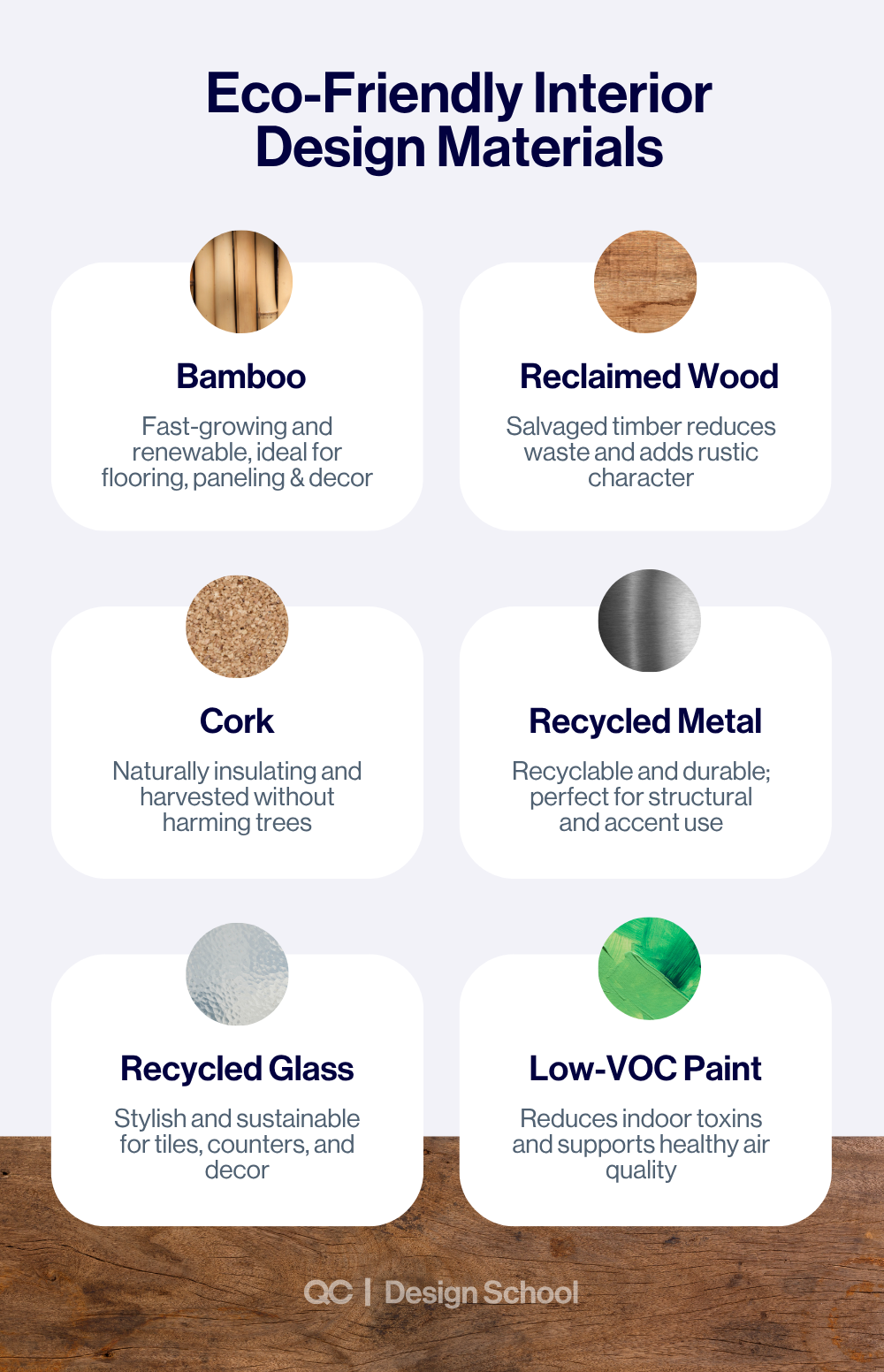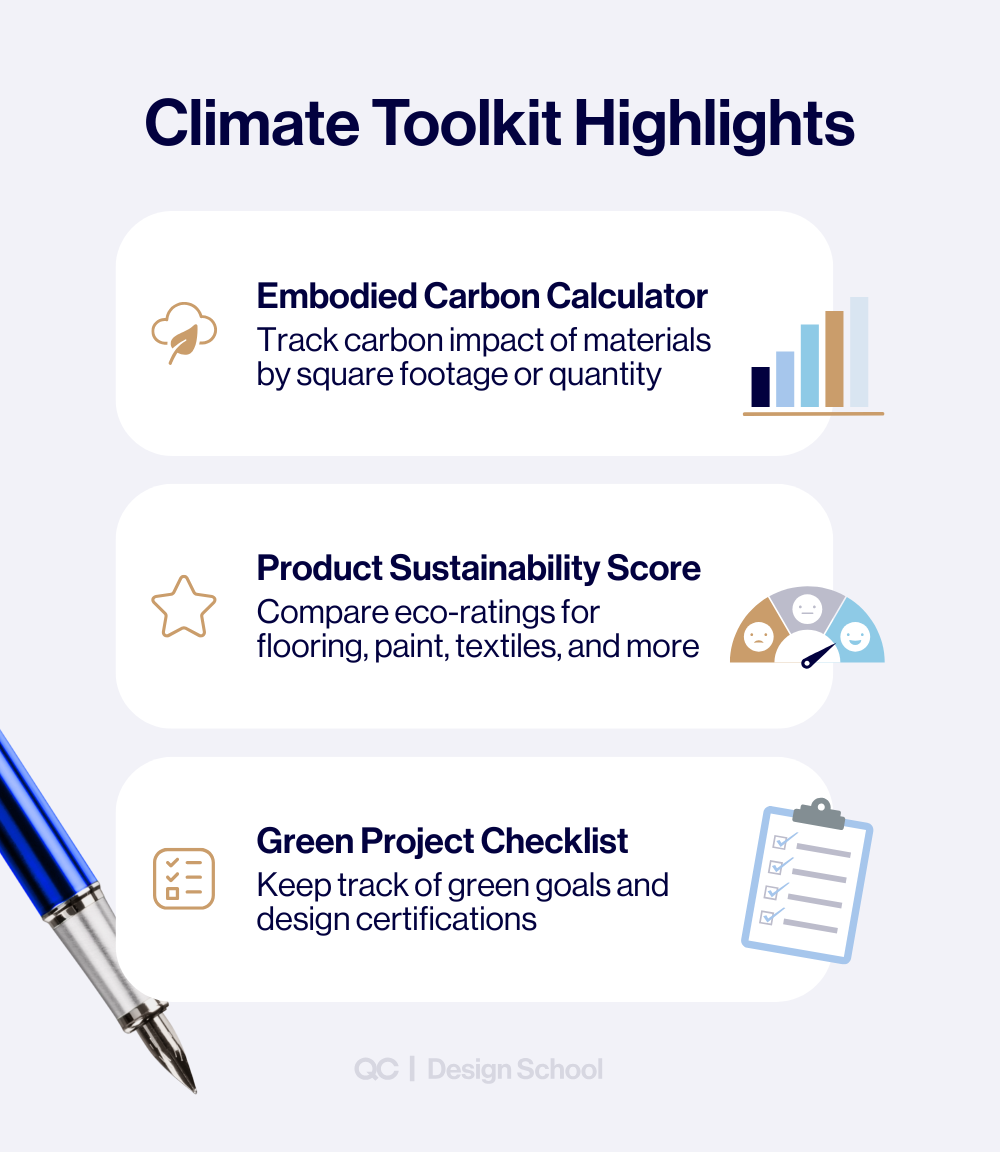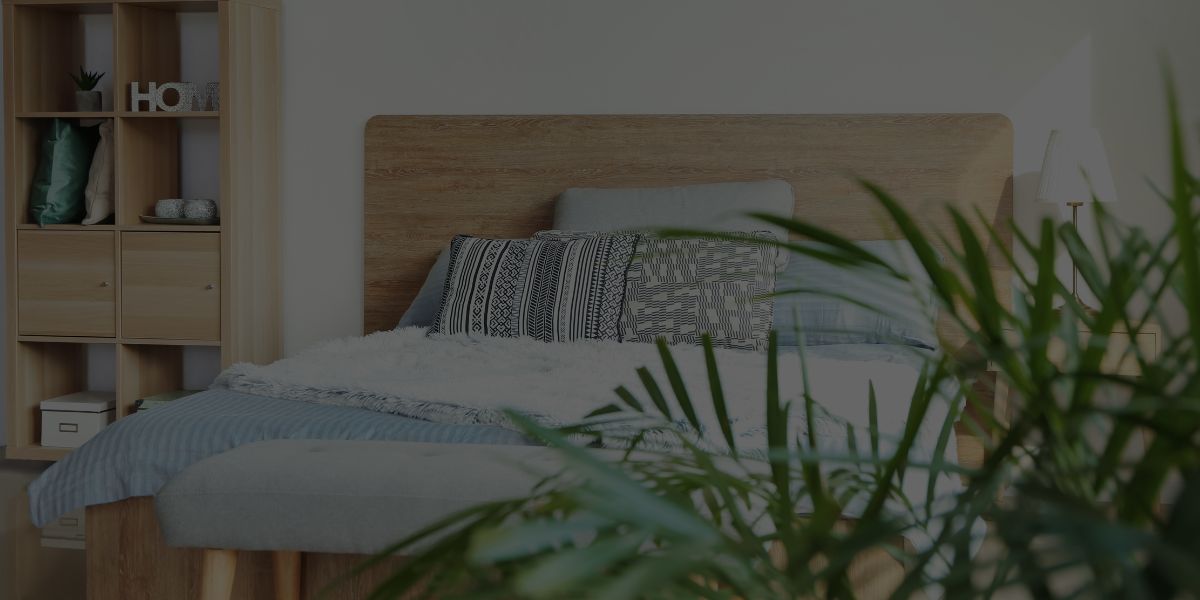Sustainable Interior Design: Key Points
- Use eco-friendly, certified materials in every design.
- Prioritize wellness, daylight, and air quality.
- Design for energy efficiency and reduced waste.
- Apply trusted tools like LEED and the Climate Toolkit.
- Online interior design training has a lower carbon footprint than in-person schools.
Introduction
Sustainable interior design is no longer a luxury or niche; it’s a professional responsibility! With growing concerns around climate change, health, and resource conservation, interior decorators and designers are at the forefront of creating spaces that are as mindful as they are beautiful. In this guide, we’ll explore everything from sustainable materials to smart energy use, certifications, and the philosophy that drives ethical, planet-first design.
Keep reading to learn how interior design with sustainable materials can shape a healthier future for clients, communities, and the planet!
Sustainability isn’t just about saving energy or choosing bamboo flooring. In reality, it’s a holistic design mindset that considers EVERY choice’s impact on the planet and people. In today’s climate-conscious world, this design approach isn’t optional for professionals—it’s expected.
Defining What Is Sustainable Interior Design
Sustainable interior design is the practice of creating functional, beautiful spaces that minimize environmental impact and prioritize occupant health. This involves:
- Reducing waste during construction and renovation
- Choosing responsibly sourced and recyclable materials
- Improving indoor air quality with low-toxicity finishes
- Designing for durability, longevity, and adaptability
Furthermore, it’s also about incorporating principles of wellness, equity, and ethical sourcing.

Sustainable vs. Green Design: What’s the Difference?
Though often used interchangeably, the two concepts are slightly different:
- Green design tends to focus on immediate environmental benefits (e.g., using recycled or organic materials).
- Sustainable design goes deeper, incorporating a full lifecycle perspective (including sourcing, manufacturing, usage, and disposal) as well as social and economic impacts.
Sustainable design is essentially the evolved, more holistic version of green design. Understanding that difference helps you better educate clients and choose smarter strategies!
Interior Design with Sustainable Materials: Choosing Wisely
The materials you select don’t just shape how a space looks—they determine its environmental footprint, indoor air quality, and longevity. As such, choosing the right ones is one of the most impactful steps in practicing sustainable interior design.
Become an Interior Designer
Earn your certification in as little as 3 months, right from the comfort of home!
Eco-Friendly Interior Design Materials to Know
Today’s market offers a wealth of beautiful, functional, and eco-friendly materials. These options combine durability, renewability, and style—ideal for residential or sustainable office interior design projects.
Here are some of the top materials to consider:
Bamboo
Fast-growing, strong, and naturally antimicrobial. Excellent for flooring, paneling, and even textiles.
Reclaimed Wood
Salvaged from old structures, this adds character while reducing demand for virgin lumber.
Cork
Harvested from cork oak trees without cutting them down. It’s naturally insulating and perfect for flooring or wall treatments.
Recycled Metal (e.g., aluminum, steel)
Highly recyclable with low maintenance needs.
Recycled Glass
Commonly used for countertops, tiles, and decorative accents.
Low-VOC Paints and Sealants
Crucial for better indoor air quality and reduced health risks.

Innovations in Sustainable Interior Design Textiles
New technologies are transforming textiles—one of the most polluting industries—into eco-forward options that support sustainable interior design.
Here are a few groundbreaking examples:
- Mycelium Leather: A plant-based leather alternative made from mushroom roots. Biodegradable and leather-like in texture.
- Algae-Based Yarns: Fast-growing algae are spun into bio-yarns that are lightweight, renewable, and compostable.
- Lab-Grown Cotton: Reduces water usage and avoids pesticides compared to traditional cotton farming.
- Recycled PET Fabrics: Made from plastic bottles, these offer durability and keep waste out of landfills.
These textiles are increasingly being used in upholstery, rugs, curtains, and accent decor. Moreover, they offer form and function without the ecological cost!
Certifications for Sustainable Interior Design Materials
Verifying whether a product is truly “green” can be tricky without official certifications. These trusted marks help you and your clients avoid greenwashing and ensure ethical sourcing:
- FSC (Forest Stewardship Council): Ensures wood comes from responsibly managed forests.
- Cradle to Cradle Certified: Evaluates products for environmental and human health through full lifecycle assessment.
- LEED (Leadership in Energy and Environmental Design): Awards points for materials used in certified buildings.
- WELL Building Standard: Focuses on how materials and design affect occupant wellness and comfort.

Sustainable Office Interior Design Strategies for Commercial Success
Sustainable office interior design is about more than adding a few plants or switching to LED bulbs. Rather, it’s a holistic approach that creates healthier, more productive workspaces while reducing operational costs and environmental impact. Businesses are increasingly recognizing that eco-friendly interiors are beneficial for the planet. Additionally, they’re beneficial for employee well-being, recruitment, retention, and even brand image!
How Sustainable Office Interiors Improve Well-Being and Productivity
When it comes to sustainable office interior design, wellness is front and center. Healthy, thoughtfully designed spaces directly influence how employees feel and perform. Here’s how sustainability supports productivity:
- Daylighting: Natural light improves mood, focus, and sleep cycles.
- Ergonomic layouts: Flexible workstations and collaborative spaces support comfort and movement.
- Biophilic design: Plants, natural textures, and outdoor views reduce stress and boost satisfaction.
- Clean air: VOC-free materials and proper ventilation reduce allergens and toxins.
- Noise control: Acoustic panels made from recycled materials reduce distractions.
These elements foster physical, mental, and emotional well-being, all while aligning with sustainability goals.
Master Feng Shui For Mindful, Sustainable Design
Enroll in QC Design School’s online Feng Shui Design Course to create eco-conscious, energy-balanced spaces!
Energy-Saving Features for Eco-Friendly Interior Design in Offices
Energy efficiency is one of the most measurable aspects of sustainable design—and one that yields immediate ROI.
Here are some top energy-saving strategies for eco-friendly office interiors:
- Motion sensor lighting: Automatically turns lights off in unoccupied spaces.
- Daylight harvesting systems: Adjust artificial lighting based on natural light levels.
- Smart thermostats & HVAC zoning: Optimizes temperature for comfort and energy savings.
- Energy-efficient window treatments: Solar shades, tinting, and thermal curtains reduce HVAC load.
- Efficient lighting: LEDs use up to 90% less energy than traditional bulbs and last longer.
What Is Sustainable Design in Practice? Tools and Frameworks for Pros
Understanding sustainable design theory is important. However, applying it requires the right tools and frameworks. These resources help professional designers make smarter decisions, communicate sustainability clearly to clients, and meet certification or regulatory standards.
Using the Common Materials Framework in Interior Design
Developed in collaboration with architects, designers, and sustainability experts, the Common Materials Framework (CMF) helps professionals evaluate building and design products across five key environmental and health categories:
- Climate Health – How materials contribute to or reduce carbon emissions
- Human Health – How materials affect indoor air quality and occupant safety
- Ecosystem Health – Impact on wildlife and ecosystems from production and disposal
- Equity – Ethical sourcing, labor rights, and social impact
- Circularity – Ability to reuse, recycle, or biodegrade
Designers can use this framework to prioritize and justify material selections, especially in client presentations or when pursuing certifications like LEED or WELL.
The Climate Toolkit for Sustainable Interior Design Professionals
One of the most practical digital tools available, the Climate Toolkit for Interior Design was developed through AIA- and industry-led workshops. It provides actionable data to help designers track, reduce, and communicate the environmental impact of materials and project decisions.
Key features include:
- Embodied carbon calculators to assess material impacts
- Product databases with sustainability scoring
- Client presentation resources (e.g., visual dashboards)
- Checklists for green goals and benchmarks

Expert Tips for Sustainable Interior Design
You’ve got the materials, frameworks, and tools… But what does it actually look like to put sustainable interior design into action? We asked design professionals what strategies they use in the field. These expert-backed practices will help you build spaces that are both environmentally responsible and client-approved.
Start with Function, Then Source Eco-Friendly Interior Design Materials
Every strong interior begins with function. Experts advise focusing on layout, traffic flow, lighting, and ergonomics before selecting finishes and decor. Once the functional needs are met, layer in sustainable materials that complement the design.
When you prioritize performance, you’re ensuring that your design won’t sacrifice comfort or usability for aesthetics—sustainable or otherwise!
Avoid Greenwashing by Vetting Certifications and Suppliers
Don’t take every “eco-friendly” label at face value. Professionals recommend doing your homework:
- Ask for third-party certifications (FSC, LEED, Cradle to Cradle, etc.)
- Request transparency documents (HPDs, EPDs, or Declare Labels)
- Choose vendors with sustainability commitments on their website or packaging
Collaborate with Clients on Sustainable Design Goals
Sustainability needs to be a shared vision. Experts say you should:
- Educate clients about long-term value (cost savings, wellness, resale)
- Discuss priorities upfront (Is the focus health? Energy use? Materials?)
- Show them sample products that are both stylish and sustainable
Setting the tone early helps align expectations and gain buy-in for bigger decisions later.
Launch A Thriving Career In Sustainable Interior Design
Gain the skills + confidence needed to grow a long-term, successful business!
Invest in Durable, Timeless Pieces Over Trendy Decor
Fast fashion isn’t just in clothing. It happens in interiors, too! As such, sustainable designers suggest investing in:
- High-quality furnishings that last for decades;
- Modular systems that can evolve with a space;
- Timeless materials like natural stone, wool, and wood tones.
Stay Current with Sustainable Design Trends and Tools
The field of sustainable design evolves constantly. So, stay sharp by:
- Following AIA and WELL updates;
- Subscribing to newsletters from Green Building Council, Dezeen, and Metropolis;
- Participating in workshops or online certification programs.
New innovations like biophilic design, passive design, and AI-powered material calculators are transforming how we work.

How to Get Started with Sustainable Interior Design
Feeling inspired to design with purpose? Whether you’re just beginning your career or looking to pivot toward greener practices, sustainable interior design is more accessible than ever. With the right mindset, tools, and training, you can start creating spaces that are beautiful, functional, and environmentally responsible!
Steps to Begin Practicing Eco Friendly Interior Design
You don’t need a complete overhaul to start designing more sustainably. Small, intentional steps make a big difference over time. Here’s how to begin:
- Audit your materials list: Replace high-VOC paints, synthetic rugs, and disposable decor with sustainable alternatives.
- Source locally when possible: Reduces shipping emissions and supports community-based artisans.
- Prioritize reuse and repurposing: Refinish or reupholster instead of replacing. Upcycled decor adds personality and reduces waste.
- Use product certifications: Look for FSC, Cradle to Cradle, GreenGuard, or Declare labels.
- Design for longevity: Choose classic pieces and neutral palettes that age well and require fewer updates.
Furthermore, keep a running list of vetted suppliers who align with your values. This will save you time and ensure consistency across future projects.
Where to Learn Sustainable Interior Design
If you’re serious about building a career rooted in sustainability, the right training is essential! Fortunately, aspiring and working interior designers now have more access than ever to flexible, credible education that incorporates sustainable practices.
Whether you’re starting from scratch or upgrading your skills, here’s what to look for and how to get started.
Look for Programs That Support Sustainable Thinking Through Smart Design
A strong interior design education goes beyond aesthetics; it helps you make intentional, thoughtful decisions that can support sustainability in the long run. While not every course will be labeled “green,” the right program will equip you with design strategies that naturally align with eco-conscious values.
As such, look for training that includes:
- Layout planning that supports natural light and airflow, which in turn helps reduce dependence on artificial systems.
- Lighting strategies that emphasize energy efficiency, such as using LEDs or layered lighting.
- Durability-focused design principles, encouraging the selection of timeless, long-lasting furnishings.
- Client-centered design thinking, helping you create functional spaces with wellness in mind.
These core principles prepare you to create interiors that are more efficient, adaptable, and wellness-focused.
Learn at Your Own Pace Through Online Interior Design Training
In addition to being flexible, online learning is inherently more sustainable than in-person schooling. This is because it reduces travel emissions, cuts paper and printing waste, and conserves campus energy resources.
Plus, many high-quality online programs teach how to:
- Research and vet green-certified materials
- Design with repurposed or locally sourced items
- Plan for long-term durability and occupant wellness
This style of training is ideal for those wanting to align their lifestyle and learning with eco-forward values.
Expand Your Services with Specialized Sustainable Skills
Some programs also offer niche training that supports green design in specific areas:
- Home Staging & Real Estate: Learn how to stage spaces using what clients already own, reducing waste and overconsumption.
- Virtual Design/eDesign: Go paperless and eliminate travel by working entirely online (an inherently eco-friendly business model).
- Landscape & Outdoor Design: Use native plants, permeable paving, and sustainable materials to bring your green ethos outside.
These specialized skills allow you to serve eco-conscious clients in more diverse and meaningful ways.
Why It Matters
FACT: The demand for sustainable interior designers is growing! Therefore, more clients want homes, offices, and outdoor spaces that are healthier, more efficient, and designed with the future in mind.
By choosing education that reflects this shift, you’ll:
- Build a competitive portfolio;
- Attract values-aligned clients;
- Stay current with design and environmental trends;
- Feel confident offering designs that are both beautiful and responsible.
🌿 Sustainability starts with education. Choose a path that equips you to design with purpose and integrity—for people AND for the planet!
QC Design School = A Greener Path Forward
QC Design School’s online certification programs offer a flexible, accessible way to pursue interior design training, WITHOUT the environmental impact of commuting, printed materials, or campus operations. For learners who value both creativity and conscious living, it’s a smart, future-focused path.
Our curriculum emphasizes:
- Thoughtful space planning that maximizes light, flow, and function.
- Smart material and furnishing choices that support long-term use.
- Design strategies that balance beauty with lasting impact.
You’ll graduate with practical skills, a polished portfolio, and the confidence to serve clients who value wellness, efficiency, and purpose-driven design.
Ready to learn how thoughtful design leads to meaningful change? QC is here to support your journey—on YOUR terms, and with the future in mind!
Frequently Asked Questions (FAQs) About Sustainable Interior Design
Your clients (even fellow designers) may have questions about sustainable interior design. This section addresses common queries using clear, SEO-optimized answers that also reinforce your expertise.
What is sustainable interior design?
Sustainable interior design is the practice of creating indoor spaces that minimize environmental impact while maximizing wellness, efficiency, and ethical responsibility. In addition, it includes using eco-friendly materials, reducing energy consumption, improving indoor air quality, and designing for longevity.
What is sustainable design in general?
Sustainable design is a broad design philosophy that prioritizes environmental stewardship, resource conservation, and social equity across multiple disciplines: interior design, architecture, fashion, product design, and more. Moreover, it also considers the full lifecycle of materials and the long-term effects of design choices.
How can I use sustainable materials in my interior design projects?
Start by choosing materials that are:
- Recycled or reclaimed (e.g., wood, metal, glass)
- Rapidly renewable (e.g., bamboo, cork)
- Certified by third parties (e.g., FSC, Cradle to Cradle)
- Low in toxins (e.g., low-VOC paints, formaldehyde-free adhesives)
Also, consider the location and durability of your materials to reduce both carbon footprint and future waste.
What’s the difference between green and eco-friendly interior design?
Green interior design often focuses on materials and energy usage. On the other hand, eco-friendly interior design is broader. It emphasizes a balance of wellness, energy, ethics, and environmental protection. Both aim for lower impact. However, “eco-friendly” typically suggests a holistic, client-centered approach.
What is sustainable office interior design?
Sustainable office interior design involves creating commercial workspaces that are healthier for employees and better for the environment. This includes:
- Smart lighting systems and daylighting strategies
- Low-VOC materials for better air quality
- Energy-efficient HVAC and ventilation
- Biophilic elements that promote well-being
- Recycled or renewable finishes like flooring and textiles
Many businesses pursue LEED or WELL certification to formalize their commitment to sustainability.

